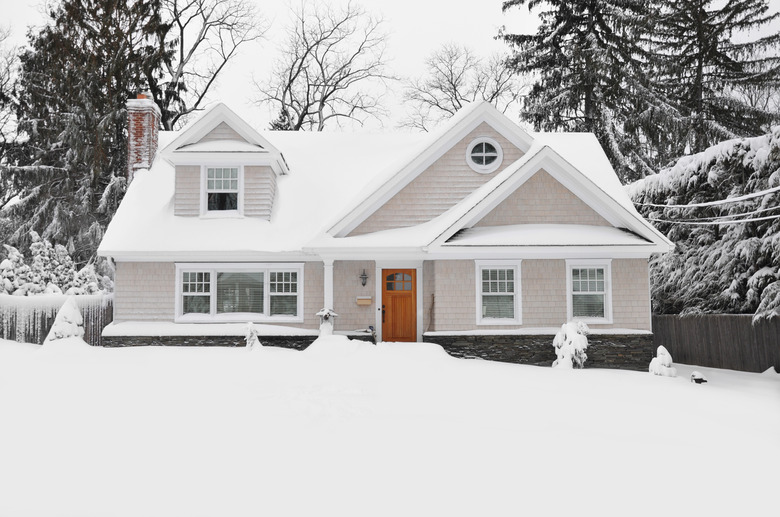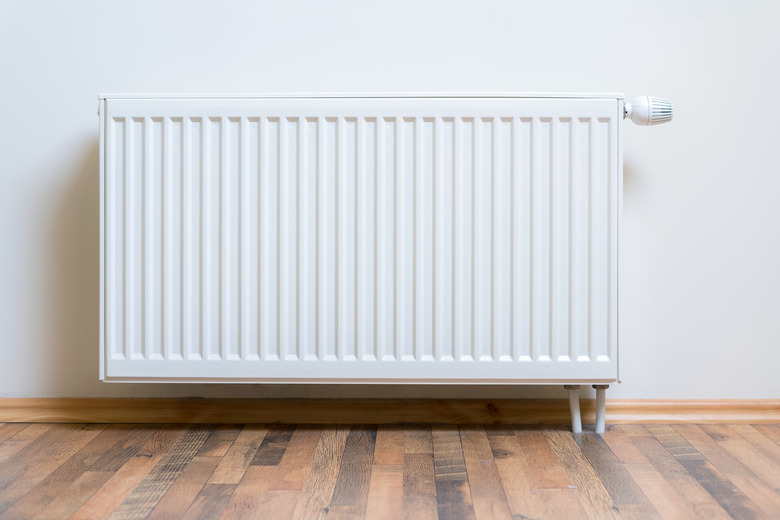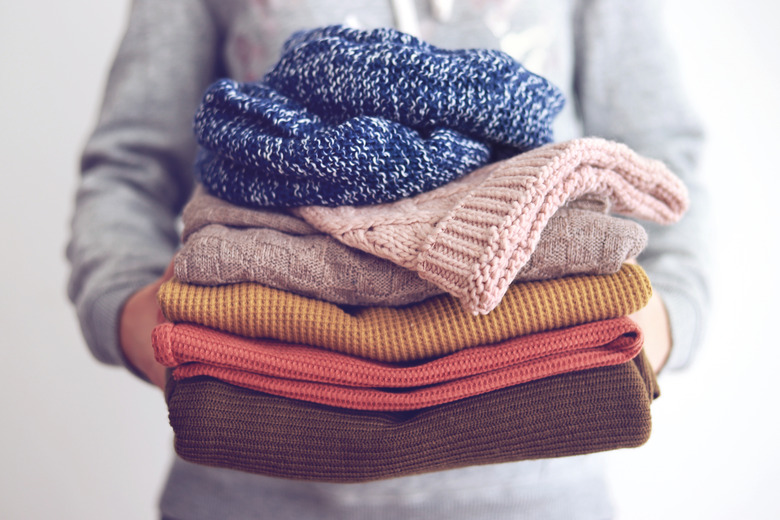Here's How To Keep Yourself (And Your Home) Safe During Extremely Cold Temperatures
We may receive a commission on purchases made from links.
There's nothing quite as cozy as sitting inside with a nice cup of hot chocolate on a cold winter's day, but cold weather can quickly go from charming to deadly. This is especially true during periods of unusually cold temperatures or when snow and ice knock out power lines and turn off the heat. Ideally, it's best for your family and pets to stay with a friend or relative in this situation if you can. If you must shelter in place, however, there are many steps you can take to keep yourself and your house warm and safe even if the power goes out.
Dress Yourself Properly
Dress Yourself Properly
It's best to stay indoors during extremely cold weather, but if you have to go out, make sure you dress properly. The best way to stay toasty and warm is to wrap your body in layers. The first layer is the one that sits next to your skin. For this layer, choose materials that hold body heat and repel moisture. Opt for wool, silk or polypropylene and avoid cotton.
The next layer is the insulation layer that will help you retain your body heat. Natural fibers work the best for this, so opt for clothing made from wool, goose down or natural fleece. Make sure that the shirt you wear in either your first or second layer is snug at the wrists to help keep cold air out and warm air in.
Finally, add an outer layer. This is the layer that protects you from elements like wind, rain and snow. Ideally, you want this layer to be tightly woven, water-resistant and wind-resistant. Always wear a hat and mittens when you're outside in the cold as well as a scarf that covers your face and mouth. Gloves will do in a pinch, but mittens are warmer and a better choice for cold weather.
Don't overlook your layers when you come in from outside. If the heat in your home goes out during extreme cold, you will need to continue layering even when you're indoors. You may need to wear thermal underwear under your pajamas at bedtime, for example.
Remember that wearing wet clothes during cold weather should be avoided. If you feel warm, remove layers of clothing, preferably before you start to sweat. Change your clothes immediately if you do get wet.
Try to Eat Right
Try to Eat Right
Depending on weather and road conditions, you may find yourself on your own for a few days during a cold-weather event. During that time, it's important to keep your strength up and stay healthy. Warm foods, like hearty soups, are an excellent choice. If the power goes out and you can't cook, try to continue eating as healthfully as you can.
Do not drink alcohol during this time. A good belt of whiskey feels nice and warm going down your throat, but alcohol encourages blood to flow away from your core and out into your extremities. This isn't what you want when you're trying to keep your vital organs warm. Avoid carbonated beverages as well.
The best thing to drink is water. If you're out of bottled water and your frozen pipes have left you high and dry, you can drink melted snow. Do so only as a last resort, however, as snow can contain harmful contaminates, especially if it has been in contact with the ground or other surfaces. When forced to drink snow, melt it and boil it for 1 minute if at all possible.
Know Cold Weather First Aid
Know Cold Weather First Aid
Frostbite and hypothermia both pose very real dangers during cold weather. Hopefully, you'll never need to know how to treat them, but it's good knowledge to have. Hypothermia occurs when your body temperature drops below 95 degrees Fahrenheit. Symptoms include uncontrollable shivering, confusion and trouble with walking and other tasks that require muscle control.
To treat hypothermia, get the victim indoors if they are not there already. Remove any wet clothing they are wearing and wrap them in blankets. You may want to sit them near a heating vent or space heater but warm them slowly. Get medical help immediately because hypothermia can cause organ damage, heart attack or even death. Don't try to warm a hypothermic person too quickly, however, and focus on warming their core before worrying about their extremities.
In cases of frostbite, fingers, toes and other tissue extremities freeze completely. The skin and the tissue beneath it, including muscles and bones, both freeze during a frostbite event. Frostbite victims lose sensation in the affected area or feel a strange tingling sensation. Frostbitten skin looks white and waxy and will be hard when you touch it.
To treat frostbite, bring the affected person to a warm place and use body heat or warm water to gradually warm the area. Do not, however, apply the heat directly to the damaged skin or rub the affected area. It's imperative that once you start warming frostbitten skin, you don't stop. Warming the area and then letting it get cold again can cause serious and permanent damage.
Wrap frostbitten skin gently in clean gauze and place gauze between affected digits so they don't rub each other. If blisters are present on the skin, avoid popping them. Frostbite can result in the loss of fingers and toes, so seek medical attention as soon as possible.
Heating the House During Extreme Cold Weather
Heating the House During Extreme Cold Weather
Hopefully, your heating system will continue to work during a spell of extremely cold weather and all that you'll need to keep warm is to crank the thermostat. To help your system tolerate the extra work it's doing, close your window blinds and drapes to reduce heat loss. Roll towels and place them next to exterior doors to keep out any drafts. If you have it, adding weatherstripping to doors and windows is an easy DIY project to keep them nice and insulated.
If your HVAC system or radiator isn't doing the trick, you can also use alternative heat sources like electric space heaters for an extra boost — but do so carefully. Never use an electric heater with a broken or damaged power cord, and plug your heater directly into the wall instead of using an extension cord. Make sure your space heater is one that turns itself off if it overheats and never leave the heater running unattended. Operate the heater on a flat, hard surface at least 3 feet away from curtains, furniture and other flammable objects.
If your heat stops working and your power is out, you can light a fire in your fireplace or wood stove to keep your home warm as long as it's safe to use. (A fireplace that hasn't been used, inspected or cleaned in the last few years probably isn't safe.) Don't burn paper in your fireplace, however, as paper flutters and can send sparks into the room. Always make sure you have a screen on your fireplace that will keep any embers safely where they belong. If you have a gas fireplace, you can turn it on for some heat also.
When you run out of heating options, you can consider a kerosene heater if you must. Kerosene heaters are illegal in some areas, so make sure you know the local rules before using one. Kerosene heaters require good airflow and ventilation to operate safely and should be paired with a battery-powered CO2 detector.
Under any circumstances, never try to use your kitchen stove to heat your home. This practice is extremely dangerous.
The Frozen Pipe Dilemma
The Frozen Pipe Dilemma
During the winter months, frozen pipes can cause major headaches, and it's best to try and avoid them. To prevent frozen pipes, open the cupboards under your sink to allow warm air from the house to circulate around the exposed plumbing. Turn all of your faucets on to a trickle as well. If you can keep the water in the pipes moving, you may be able to stop them from freezing.
If you're not sure that this will be enough to prevent freezing, fill some jugs with water while you still can. That way, you can have some water on hand to drink later if you need it.
Sometimes, pipes freeze despite the steps you take to prevent it. If so, thaw your pipes slowly with a hairdryer or by wrapping them in a heated blanket. You may get a rush from busting out a blow torch to use on your pipes but avoid doing so, as this can do more harm than good.
Generator Safety Tips
Generator Safety Tips
Depending on the size of the generator, you probably won't be able to power your entire house if a cold-weather incident results in lost power. A generator is enough, however, to run necessary medical equipment or to run an electric space heater.
To stay safe, never run a gas-powered generator indoors for any reason. Keep your generator outside and position it 20 feet away from your home's doors and windows. Always plug appliances into the generator itself. You can use an extension cord to do so but make sure it's a heavy-duty cord rated for outdoor use. When the generator runs dry, allow it to cool before adding more gasoline.
Additional Cold Weather Safety Tips
Additional Cold Weather Safety Tips
Cold weather often accompanies snow and ice storms. To keep yourself safe, it's important that you dress properly and take your time when cleaning up Mother Nature's mess. Cold weather makes your body work harder even when you're sitting still. Adding the stress of shoveling and snow blowing can exacerbate the issue.
If you have some work to do outside, it's best to clear it with your doctor before you dig in. Take frequent breaks and listen to your body. If you're starting to shiver or feel tired, go inside and take a break.
If the power is out when you do go inside, use a battery-powered flashlight or lantern to produce light. You can use candles if you have no other choice but be extremely careful if you do. The open flame of a candle can start a house fire and should always be attended. Battery-powered candles are a much safer alternative.
Finally, remember to check on all your friends and family during cold weather, including your pets. Cats and dogs can get hypothermia and frostbite just like people. Keep your pets indoors during cold weather and make sure they stay warm enough. Provide blankets and perhaps a hot water bottle for your pets as well as your people and enjoy a little extra snuggle time.
References
- AARP: How to Stay Safe in Extreme Cold
- American Red Cross: Follow These Safety Steps as Winter Storms Hit Your Community
- Centers for Disease Control and Prevention: Stay Safe During & After a Winter Storm
- Government of Canada: Seven Steps to Cold Weather Safety
- National Institute on Aging: Stay Safe in Cold Weather!


